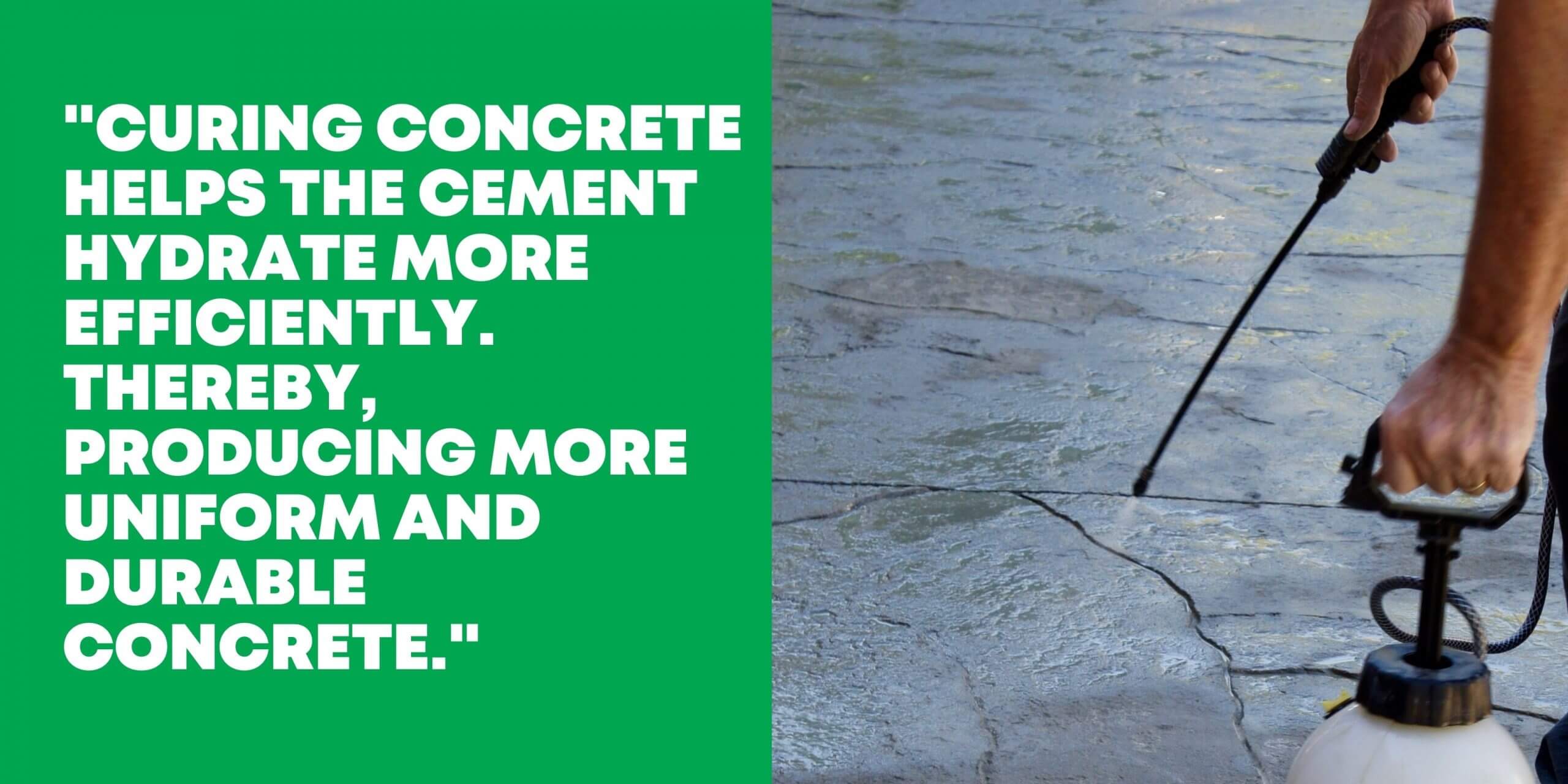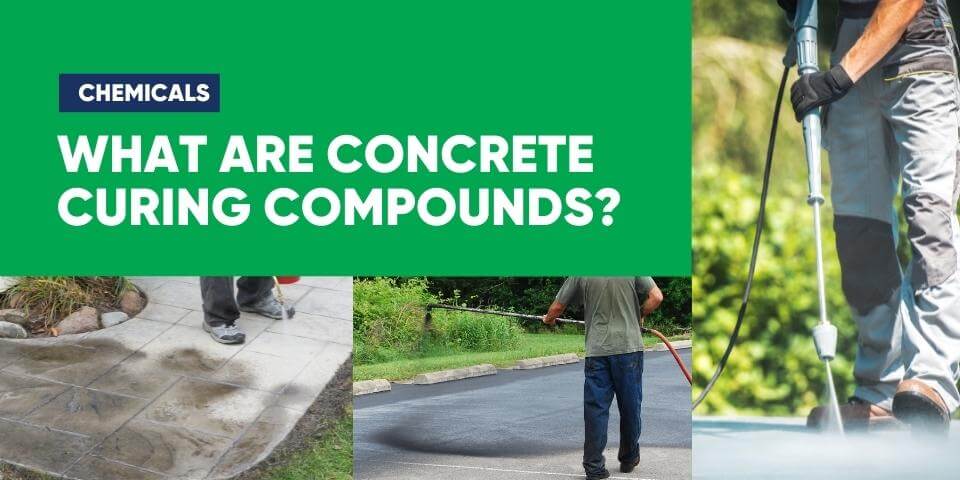

In this article, we would like to help you understand what Concrete Curing is and why it is important. From there, we try to understand the different ways in which concrete can be cured. And lastly, we answer the question “How do I select the right method to cure concrete?”
To start off, we take a quick minute to understand what is concrete.
Concrete is basically a mixture of cement, water, and aggregate. When these three ingredients are mixed together, the cement forms a paste that coats the sand and rock particles. This paste plays an essential role in hardening the concrete.
Over time, the cement hydrate becomes stronger and denser as it absorbs water from its surroundings. Eventually, it fully hardens and creates a solid mass of concrete that is strong enough to support heavy loads.
Concrete cures by holding moisture in the slab for an extended period of time. Proper curing increases the strength and durability of concrete. Concrete that is under-cured or over-cured can suffer from low strength, low density and volume changes that lead to cracking or delamination.
Concrete Curing is vital for this process because it helps keep moisture levels in the concrete high as it hydrates with water so that curing can be completed properly.
As concrete is a porous material – curing aims to prevent moisture loss that occurs naturally through evaporation. This prevention of moisture loss enables the concrete’s hydration process to finish properly before the surface of the concrete becomes too dry.
There are three major methods for curing concrete, they are:
Water curing is when you wet the surface of fresh concrete with water so there’s enough moisture in it as it cures.
Membrane curing involves applying a coating to fresh concrete, such as an evaporation retarder or sealing compound, so that less moisture evaporates off the surface.
Air or Steam curing is when you keep a slab moistened by heating it with moist hot air which helps speed up the concrete setting process whilst keeping the moisture on the surface of the concrete.
Concrete Curing compounds fall in the category of “membrane curing”.
Curing compounds typically contain polymers that form a protective membrane or film over a concrete surface once applied. This membrane helps retain water and moisture on a concrete surface until it has reached its optimal strength and durability potential.
Some curing compounds may also contain pigments for aesthetic purposes, as well as antimicrobial agents for added protection against microbial growth and contamination on newly installed concrete surfaces.
As mentioned before, the main purpose of concrete curing is to slow the rapid rate of moisture loss from the concrete. This allows sufficient time for the cement particles to hydrate and provide the desired strength and durability.
In summary, a concrete curing compound is a synthetic material designed to cure the concrete by preventing it from drying out. It works by forming a layer on top of the concrete that prevents evaporation, which in turn can cause slow and even curing. This has several advantages over traditional methods, including: it’s more cost effective and requires less labor.
Curing compounds can be made with different types of chemical bases to achieve different types of outcomes. Some will have higher levels of water retention than others.
User AS3799 there is a minimum threshold of 90% of water retention that must be achieved.
Curing compounds are classified according to the requirements of AS3799. To comply with AS3799, curing compounds must retain >90% of the original water in concrete over a 72 hour test (Curing Efficiency). Different curing compounds will have different levels of water retention efficiency, and suitability/compatibility to post applied coverings/materials.
Most PVA based compounds will provide an adequate process to cure the concrete but will not reach the minimum AS3799 requirement of 90% water retention.
A blend of acrylics sets on the concrete surface. This is a preferred choice where after trades will apply other acrylic based products like paint orrenders. Most Acrylic compounds reach the minimum AS3799 requirement of 90% water retention.
A blend of synthetic petroleum and resin based hydrocarbons will seal the concrete by forming a membrane with the advantage of a rapid film formation time.
Wax compounds have similar properties like resin compounds. The wax membrane suits large areas like runways or bridges.
Bitumen concrete curing compounds are a blend of bitumen resins and hydrocarbons which not only cures concrete but it also acts as a primer coat for asphalt and bitumen overlays. It is ideally suitable for bridge decks and road construction.
Chlorinated rubber type curing compounds will form a thick layer when applied. It seals the concrete tightly and also fills the minute pores present in the concrete. This will accommodate most carpet and vinyl adhesives.
Most curing compounds must be removed before the application of any film forming coating.
The only exception to this are acrylic bases when there will be subsequent application of acrylic paints and coatings, provided the correct drying times are followed.
In general, most removal of all other curing compounds is via mechanical methods such as shot blasting or grinding, not using chemical treatments.
Some curing compounds such as will degrade with direct UV exposure. UV degradation can be from 7 to 60 days, but the degradation time depends on factors such as application thickness, exposure time, level of exposure and porosity of the concrete. Keep in mind that not all surfaces may be exposed to direct UV sunlight at the same rates, so there will likely be differing degrees of degradation around a site.
There are several different types of curing compounds; some produce a glossy finish while others provide a matte finish. Curing compounds are often used in outdoor environments, such as parking lots or footpaths. However, they can also be used indoors for projects where a specific type of finish is desired.
The type used is going to be determined by the suitability of the area to be cured and what may be applied afterwards. – ie concrete road decks may have bitumen applied on top, so a Bitumen based compound may be necessary, whilst an office high rise concrete floor, that will take carpet or tiles may prefer an acrylic/resin or chlorinated rubber curing compound.
For more information about Concrete Curing and the various types of Concrete Curing Compounds stocked by Actech, please feel free to reach us at 1300 ACTECH.
Send your inquiry here and our experts will do their best to help you.